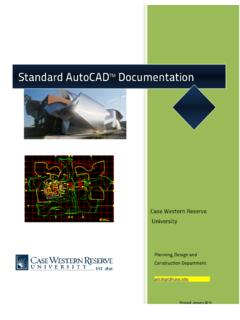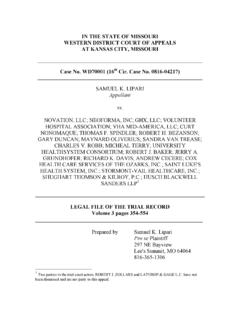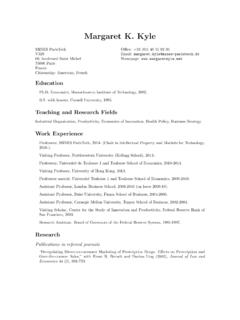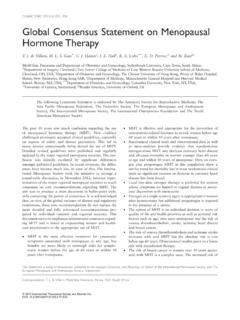Transcription of Cleveland and the Ohio and Erie Canal - irisharchives.org
1 Cleveland and the ohio and Erie Canal Geography is destiny. The territory that became the state of ohio in 1803 is bounded on the north by Lake Erie and on the south by the ohio River. As soon as surveyors began mapping the relative placement of these two waterways in the mid-18th century, the idea of connecting them took hold. George Washington was writing to Thomas Jefferson about the feasibility of a Canal linking the ohio River and Lake Erie as early as 1788. Canal fever gripped the neighboring state of New York first;. the Erie Canal , which spanned 365 miles from Albany on the Hudson River to Buffalo on Lake Erie, began construction in 1818. In 1818, Cleveland was an upstart village. A surveying party employed by the Connecticut Land Company had first staked out plots of land along the banks of the Cuyahoga River only two decades earlier, in 1796.
2 At the time of the 1820 census, the settlement contained 606 inhabitants. But when the state legislature began discussing the prospect of a Canal , the town's enterprising citizens were already lobbying for their location at the mouth of the river to be chosen as the Canal 's northern terminus. In fact, Alfred Kelley, the first president of the village of Cleaveland (as it was often spelled then), championed the cause so vigorously that he was tapped to become Canal Commissioner in 1824. When completed, the ohio and Erie Canal extended 308 miles from Cleveland to Portsmouth, much of it through undeveloped territory. The Canal attracted settlers who were willing to clear the land for farming, as is evident from an ad touting farm land in Newburgh that appeared in the Cleaveland Herald newspaper on September 14, 1827. And indeed, much of the Canal route passed through land that remained farm country.
3 The WRHS Library has a series of photographs of Canal locks, many of them taken in the 1890s. Note the bucolic character evident in the photograph of Lock 39 near Rockside Road, for example. Quite different from the densely built-up intersection of interstates 480. and 77 in the same location today! Farmers benefitted from proximity to the Canal because they were able to ship produce and crops to markets up and down the Canal route. The movement of such goods was in fact the primary impetus for the Canal . And Cleveland , strategically located at the nexus between Canal and lake traffic, was well positioned to capitalize on the commercial opportunities that the Canal afforded. Cleveland became the headquarters for wholesalers--merchants who bought, transported, warehoused, and resold groceries, textiles, and other supplies, intended for a web of destinations, fanning both inland and outward toward the entire Great Lakes region.
4 The Canal followed a route east of the Cuyahoga River, though with fewer twists and turns than those of the waterway that the Mohawk Indians called Crooked River. Present-day Canal Road marks its course through The Flats or flat-land at the bottom of the river valley. The Canal then cut across the top of the Oxbow Bend peninsula, letting out into the Cuyahoga River under the Merwin Street Bridge just south of where Superior Street met the river. The Oxbow Bend peninsula became a commercial hub for warehouses and stores and was dubbed Cleveland Centre. Commercial activity quickened the pace of growth. At the time of the 1830 census, population stood at 1,075, but by 1840 the city was bustling with the enterprise of 6,701 citizens. In the next decade, the city nearly tripled in size again, reaching a total of 17,034 in 1850. PHOTOGRAPHS: Left: Canal Commissioner Alfred Kelley; contemporary advertisements for Canal -related shipping and wholesale activity.
5 Below: Lock 39 in the 1890s, near Rockside Road; 1827 sale notice for a farm in Independence touts proximity to the Canal . Photographs courtesy of Western Reserve Historical Society. The Irish and the Canal Work on the ohio and Erie Canal , which began in Cleveland in 1825, attracted droves of newcomers to the area. Individuals of Irish descent were undoubtedly already numbered among the pre- Canal settlers. An Irish-born trapper named George Croghan was the first known white man to operate a trading post along the Cuyahoga River in the 1740s, for instance. And Judging by such last names as McMurphy and McIntost, some of the early settlers may have been of so-called Scotch-Irish origin Scottish Presbyterian families who had been planted by the English in northern Ireland in the early 17th century and who made their way to America a few generations later.
6 But the first notable influx of Irish immigrants was prompted by the need for laborers to dig the Canal . The Canal engineer contracted with individuals who would hire others to form work gangs. The records of the ohio Board of Canal Commissioners are preserved in the library of the Western Reserve Historical Society. Scan the collection of payment vouchers for work completed from 1824 to 1826, and Irish names jump out repeatedly: McCarthy, Dunn, Gannon, McGonigle, Patton, McKeever, Whelan, McNamara, and Gallagher, to name a few. Who were these men? What became of them? Toiling for $5 a month under wretched conditions, most left little, if any, trace in public records. Look for a sampling of their names in Cuyahoga County in the index for the 1830 United States census, or in the first Cleveland city directory in 1837, and the search is fruitless. Some of these laborers may have found subsequent work in Cleveland .
7 For instance, after the first span of the Canal opened between Cleveland and Akron in 1827, the city fathers decided to rechannel the last stretch of the meandering Cuyahoga River so that goods could travel more directly and efficiently from the new Canal to the lake. While some of the immigrant laborers stayed in the city to dig out the new river channel and mouth, others surely followed the Canal work south. For instance, a few Gallighers . can be found in the 1830 census in Muskingum County, where Commissioner Kelley's headquarters were located for several years. And where were the Irish immigrants amidst the growth occasioned by the ohio and Erie Canal ? Many of the Canal workers squatted at first in camps of temporary tar-paper shacks and lean-tos in the low-lying, marshy area along the lake shore that was known as Whiskey Island, north of what was soon to become the old river channel.
8 But in the official language of the 1990. application for including Irishtown Bend in the National Register of Historic Places, Owing to the geographically transient nature of Canal construction, most of the several thousand Irish who came to Cleveland at this time did not remain in residence. Still, in 1831, a real-estate development company purchased the farm on Whiskey Island that had belonged to the family of Lorenzo Carter, Cleveland 's first permanent white settler, and began selling small lots for building houses. A map drawn up in 1835 by surveyor Ahaz Merchant, the city's first commissioner of streets, shows a grid of streets in the Whiskey Island area a sure sign that some of these Irish immigrant laborers were already here to stay. PHOTOGRAPHS: Ahaz Merchant's 1835 map of Cleveland and of an 1826 Canal payment voucher. Courtesy of Western Reserve Historical Society.
9 The Canal and the Growth of Cleveland The traffic that connected Canal to river to lake produced other kinds of new jobs for immigrants. Some found work at the ship building and repairing companies that sprouted up along the old, abandoned river channel at the south end of Whiskey Island and in a dry dock area along Canal Street. In addition, all of the goods being shipped into or out of the city the newspaper ads of the day call this activity forwarding --required docks and dock workers to load and unload the boats. And as the business of the city became increasingly industrialized, work on the docks attracted more and more immigrants to the city. The years when industry was beginning to take hold the late 1840s and early 1850s happened to coincide with the tragedy of the Great Hunger or famine that was driving scores of new Irish immigrants to American shores.
10 Bypassing the already crowded cities on the country's east coast, these immigrants flocked to the growing cities of the American midwest Cleveland among them. It has been estimated that there were 500 Irish immigrants living in Cleveland in 1826, and 1024 in 1848 one of the first years when famine survivors were beginning to arrive. By 1870, the number of Irish immigrants living in the city had reached 10,000, or about 10% of the city's population at the time. The story of how these immigrants formed communities and created a new life for themselves in their adopted home represents another chapter in a long story. But the first installment of the story of the Irish in Cleveland is indisputably intertwined with the history of the Canal . Already in 1851, the eclipse of the Canal was forecasted when the Cleveland , Columbus, and Cincinnati railroad began its operations.







